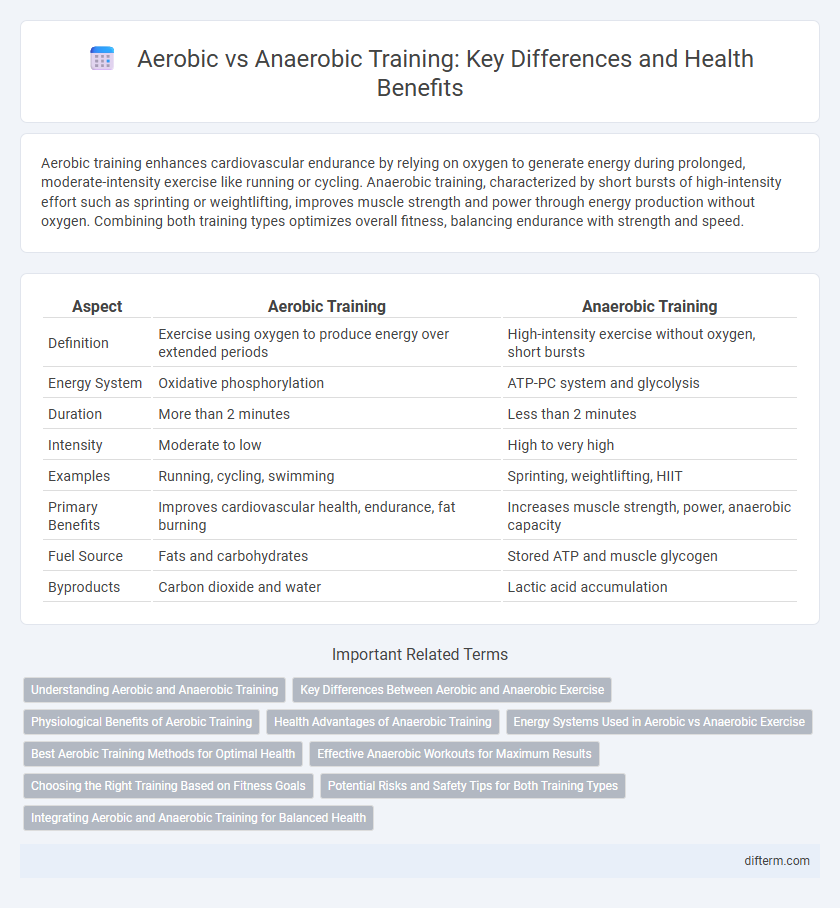Aerobic training enhances cardiovascular endurance by relying on oxygen to generate energy during prolonged, moderate-intensity exercise like running or cycling. Anaerobic training, characterized by short bursts of high-intensity effort such as sprinting or weightlifting, improves muscle strength and power through energy production without oxygen. Combining both training types optimizes overall fitness, balancing endurance with strength and speed.
Table of Comparison
| Aspect | Aerobic Training | Anaerobic Training |
|---|---|---|
| Definition | Exercise using oxygen to produce energy over extended periods | High-intensity exercise without oxygen, short bursts |
| Energy System | Oxidative phosphorylation | ATP-PC system and glycolysis |
| Duration | More than 2 minutes | Less than 2 minutes |
| Intensity | Moderate to low | High to very high |
| Examples | Running, cycling, swimming | Sprinting, weightlifting, HIIT |
| Primary Benefits | Improves cardiovascular health, endurance, fat burning | Increases muscle strength, power, anaerobic capacity |
| Fuel Source | Fats and carbohydrates | Stored ATP and muscle glycogen |
| Byproducts | Carbon dioxide and water | Lactic acid accumulation |
Understanding Aerobic and Anaerobic Training
Aerobic training involves sustained, moderate-intensity exercise that relies on oxygen to fuel muscle activity, enhancing cardiovascular endurance and promoting fat oxidation. Anaerobic training consists of short bursts of high-intensity effort where oxygen demand exceeds supply, leading to energy production through anaerobic metabolism, which boosts muscle strength and power. Understanding the distinct energy systems and physiological responses is crucial for designing effective workout programs tailored to targeted fitness goals.
Key Differences Between Aerobic and Anaerobic Exercise
Aerobic exercise primarily uses oxygen to fuel continuous, moderate-intensity activities such as running or cycling, enhancing cardiovascular endurance and lung capacity. Anaerobic training involves short bursts of high-intensity effort like sprinting or weightlifting, relying on energy stored in muscles without oxygen, which promotes muscle strength and power. Key differences lie in energy systems, exercise duration, intensity, and physiological adaptations including aerobic training improving overall stamina and anaerobic training boosting muscular strength and anaerobic capacity.
Physiological Benefits of Aerobic Training
Aerobic training enhances cardiovascular efficiency by increasing heart stroke volume and promoting capillary density in muscles, leading to improved oxygen delivery and utilization. It stimulates mitochondrial biogenesis, boosting cellular energy production and endurance capacity. Consistent aerobic exercise reduces blood pressure, improves lipid profile, and enhances insulin sensitivity, contributing to overall metabolic health.
Health Advantages of Anaerobic Training
Anaerobic training enhances muscle strength and power by promoting fast-twitch muscle fiber development, which contributes to improved metabolic rate and increased fat loss. This type of exercise boosts bone density and elevates insulin sensitivity, reducing the risk of osteoporosis and type 2 diabetes. High-intensity anaerobic workouts also stimulate growth hormone release, supporting muscle repair and overall health maintenance.
Energy Systems Used in Aerobic vs Anaerobic Exercise
Aerobic training primarily utilizes the oxidative energy system, relying on oxygen to convert carbohydrates and fats into ATP for sustained, low-to-moderate intensity exercise lasting beyond two minutes. Anaerobic training depends on the phosphagen system and anaerobic glycolysis, producing energy quickly without oxygen for short bursts of high-intensity effort lasting from a few seconds to around two minutes. Understanding these distinct energy systems helps optimize training protocols for endurance versus power and speed performance.
Best Aerobic Training Methods for Optimal Health
Best aerobic training methods for optimal health include activities like brisk walking, running, cycling, and swimming that improve cardiovascular endurance and enhance oxygen utilization. Consistent moderate-intensity aerobic exercise for at least 150 minutes per week promotes heart health, reduces the risk of chronic diseases, and supports weight management. Incorporating interval training and maintaining a target heart rate between 60-80% of maximum heart rate maximizes fat burning and boosts overall metabolic function.
Effective Anaerobic Workouts for Maximum Results
Effective anaerobic workouts, such as high-intensity interval training (HIIT), sprinting, and resistance training, maximize muscle power and promote rapid fat loss by increasing lactic acid production and enhancing anaerobic capacity. Key metabolic benefits include improved muscle strength, increased fast-twitch muscle fiber recruitment, and elevated post-exercise oxygen consumption (EPOC), leading to greater calorie burn after workouts. Integrating short bursts of maximum effort with rest intervals optimizes performance gains and boosts overall athletic endurance more efficiently than steady-state aerobic exercises.
Choosing the Right Training Based on Fitness Goals
Aerobic training, characterized by activities like running and cycling, primarily enhances cardiovascular endurance and promotes fat burning through sustained oxygen usage. Anaerobic training, involving high-intensity exercises such as sprinting and weightlifting, targets muscle strength and power by relying on energy sources stored in muscles without oxygen. Selecting the right training depends on fitness goals: choose aerobic for improving endurance and weight management, whereas anaerobic is ideal for building muscle mass and increasing short-term energy output.
Potential Risks and Safety Tips for Both Training Types
Aerobic training carries risks like overuse injuries, dehydration, and cardiovascular strain, while anaerobic training may cause muscle strains, joint stress, and increased blood pressure. To minimize injury, ensure proper warm-up, maintain hydration, and monitor intensity based on individual fitness levels. Consulting with a fitness professional and allowing adequate recovery time are essential safety measures for both aerobic and anaerobic workouts.
Integrating Aerobic and Anaerobic Training for Balanced Health
Integrating aerobic and anaerobic training enhances cardiovascular endurance while promoting muscle strength and power, creating a well-rounded fitness regimen. Aerobic exercises such as running or cycling improve oxygen utilization and fat metabolism, whereas anaerobic activities like weightlifting and sprinting boost muscle hypertrophy and anaerobic capacity. Combining both training types optimizes overall metabolic function, supports weight management, and reduces risk of chronic diseases.
Aerobic training vs Anaerobic training Infographic

 difterm.com
difterm.com